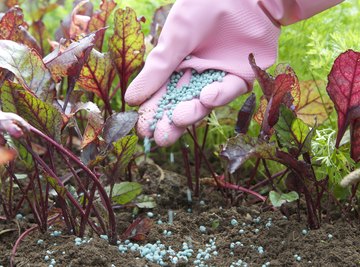
Plants can reproduce in a number of ways, but those with flowers do so through pollination and fertilization. This process is similar to the reproductive method used by most animals in that it requires two sex cells, called gametes, to be united together, forming a single fertilized cell with unique genetic material, known as a zygote. In flowering plants, the zygote forms a seed.
The Parts of a Flower
Flowering plants contain gametes, which have half of the number of chromosomes in the plant. These must be combined with other gametes to create a seed with the full number of chromosomes. The male gametes of a flower are found in the pollen that grows on the stamen, whereas the female gametes are found in the ovule inside the pistil.
The stamen is made of the anther and the filament. The anther is where the pollen is located at the end of the stamen. The pistil is made of three parts: The ovary, the style and the stigma. The ovary contains the ovules, which need to be fertilized in order to produce a seed. The ovules contain an egg nucleus and polar nuclei.
Although many plants grow unisexual flowers that have both male and female parts, others grow flowers that have only a pistil or only a stamen. Some of these species have flowers of both sexes on an individual plant, known as a monoecious plant, while others only grow one or the other, known as a dioecious plant. Dioecious plants must be located near each other in order to reproduce. Hibiscus and lily flowers are unisexual and have both parts. Squash are monoecious, which is why only half of the blossoms will ever grow into vegetables. Holly is an example of a dioecious plant as it only grows stamen on some plants, while others only grow pistils.
Pollination in Plants
The pollination process is that which occurs when the pollen leaves the stamen and lands on the stigma. In some plants, the pollen and stigma can come from the same flower or plant, which is known as self-pollination. In other plants, the pollen must come from a different plant than the stigma, which is known as cross-pollination. Although self-pollination is easier to achieve, it does not ensure as much genetic diversity as cross-pollination, leaving those plants more susceptible to problems, such as disease. Dioecious plants can only be pollinated with cross-pollination.
One of the most well-known types of pollination in plants is that involving another creature, such as a bird or bee. The creature will land on a flower to get nectar from the flower and brush against pollen in the process. The animal will then transfer the pollen to the stigma of that flower or other nearby flowers.
The other most common method of pollination involves nothing more than the wind, which knocks pollen loose from the stamen and blows it through the air until it hopefully lands on the stigma of a flower.
Fertilization of Flowering Plants
When the pollen lands on the stigma, the fertilization process begins. The sperm nuclei then travel down the style through a pollen tube into the ovary, where it enters an ovule. At this point, one of the sperm nuclei will unite with the egg nucleus and create a zygote. The other will unite with two polar nuclei to create an endosperm nucleus. The egg and endosperm nucleus grow inside the fertilized ovule and develop into a seed eventually.
The ovary will then produce a fruit to protect the seed. This could be a fruit protecting a single seed, such as an avocado, while others have many seeds, such as a kiwi.
References
- Science Learning Hub: Pollination and Fertilisation
- Britannica: How Flowering Plants Reproduce
- Gardening Know How: Dioecious And Monoecious Information – Learn About Monoecious And Dioecious Plants
- Science Learning Hub: Plant Reproduction
- Quatr.us from Professor Carr: How Flowers Reproduce – Plant Biology
- Lumen Learning: Pollination and Fertilization
About the Author
Jill Harness is a writer from San Diego with 10 years of experience working on some of the top blogs online. While she has written on a wide variety of topics, she specializes in SEO-driven legal content. More information her career can be found on her website, JillHarness.com
